GWT Overview And Feature Preview - SV Web JUG - June 16 2009
- 1. Google Web Toolkit Overview and Feature Preview Silicon Valley Web JUG June 16, 2009 Fred Sauer Developer Advocate [email protected] Saturday, June 20, 2009
- 2. Agenda • What to do about questions? • How do you pronounce GWT? • Introduction • Selecting a language • Feature tour • Who's using GWT? • Compiler, Generator, Linker • What’s new in 2.0, roadmap • Q&A Saturday, June 20, 2009
- 3. Introducing GWT Saturday, June 20, 2009
- 4. Google-Web-Toolkit "GWT's mission is to radically improve the web experience for users by enabling developers to use existing Java tools to build no-compromise AJAX for any modern browser." Saturday, June 20, 2009
- 5. Google-Web-Toolkit Productivity and Performance •Productivity for you •Performance for your users Saturday, June 20, 2009
- 6. No plugins required Silverlight VML Flash Saturday, June 20, 2009
- 7. What we don't want Saturday, June 20, 2009
- 8. An idea Productivity for you Performance for your users Saturday, June 20, 2009
- 9. HTML, JavaScript, CSS Saturday, June 20, 2009
- 10. GWT Browser-Proofs Your JavaScript Code... IE Firefo x i Safar e m Chro Opera Saturday, June 20, 2009
- 11. A More Powerful Web, Made Easier Saturday, June 20, 2009
- 12. Speed matters 0.1 seconds perceived as instantaneous. 1 second maintains the feeling that a single task is being carried out. 10 seconds limit for keeping user’s attention. Saturday, June 20, 2009
- 13. Another reason speed matters • Each cycle provides feedback • Each cycle is a 1. User 2. UI Action Changes learning opportunity • A faster UI => shorter learning curve 3. User Learns Performance for your users Google Web Toolkit Saturday, June 20, 2009
- 14. Speeding up Compilation 2.0 186 Productivity for you 1.6 144 -localWorkers=2 113 Good -draftCompile 61 Two Permutations 20 12 2 Hosted Mode Hosted Mode Startup Refresh Times gathered using Showcase on a 2-core MacBook Pro 14 Saturday, June 20, 2009
- 15. Selecting a language Saturday, June 20, 2009
- 16. Rich ecosystem of tools and libraries + + = Saturday, June 20, 2009
- 17. Code completion and javadoc Saturday, June 20, 2009
- 18. Can you find the bug? Hint: JavaScript is a dynamic language Saturday, June 20, 2009
- 19. Catch errors at compile time Java is a static language Saturday, June 20, 2009
- 20. Feature tour Saturday, June 20, 2009
- 21. Site integration options Saturday, June 20, 2009
- 22. More than just a compiler Saturday, June 20, 2009
- 23. Abstractions • Widgets • Events • DOM (compatibility & convenience) • History • Unit Testing • RPC • JSON, XML • JSOs - JavaScript Overlay types • Gears, GViz, Maps, ... Saturday, June 20, 2009
- 24. Event handling Button button = new Button("Click me"); button.addClickHandler(new ClickHandler() { public void onClick(ClickEvent event) { Window.alert("Hello, world."); } }); Saturday, June 20, 2009
- 25. Bookmark application state Saturday, June 20, 2009
- 26. We used to expect this and... Saturday, June 20, 2009
- 27. But now we expect this Saturday, June 20, 2009
- 28. RTL languages Saturday, June 20, 2009
- 29. Rich text editor Saturday, June 20, 2009
- 30. Drag and drop in the browser Saturday, June 20, 2009
- 31. Widget libraries • GWT (http://code.google.com/webtoolkit/) • Incubator (http://code.google.com/p/google-web-toolkit-incubator/) • Smart GWT (http://code.google.com/p/smartgwt/) • GWT-Ext (http://code.google.com/p/gwt-ext/) • IT Mill Toolkit (http://www.itmill.com/) • GWT mosaic (http://code.google.com/p/gwt-mosaic/) • Ext GWT (http://extjs.com/products/gxt/) • Advanced GWT Components (http://advanced-gwt.sourceforge.net/) Saturday, June 20, 2009
- 32. Simple, powerful RPC • Many formats: JSON, XML, custom • Why not just speak one language? interface SpellService extends RemoteService { /** * Checks spelling and suggests * alternatives. * @param the word to check * @return the list of alternatives */ String[] suggest(String word) } Saturday, June 20, 2009
- 33. WAR directory structure Saturday, June 20, 2009
- 34. App Engine and Google Web Toolkit (GWT) Easier to Scale and Optimize Your App Saturday, June 20, 2009
- 35. App Engine for Java http://code.google.com/appengine Saturday, June 20, 2009
- 36. Google Plugin for Eclipse http://code.google.com/eclipse/ Saturday, June 20, 2009
- 37. Disappearing Code - JavaScript Overlays Saturday, June 20, 2009
- 38. Disappearing code - JavaScript overlays Let the Google Plugin for Eclipse work for you Saturday, June 20, 2009
- 39. Disappearing code - JavaScript overlays // Magic disappearing class public class Person extends JavaScriptObject { protected Person() {} final public String getDisplayName() { return getFirstName() + " " + getLastName(); } final public native String getFirstName() /*-{ return this.firstName; }-*/; final public native String getLastName() /*-{ return this.lastName; }-*/; } Saturday, June 20, 2009
- 40. Disappearing code - JavaScript overlays // You write Window.alert("Hi, my name is " + person.getDisplayName()); // GWT translates $wnd.alert('Hi, my name is ' + (person.firstName + ' ' + person.lastName)); Saturday, June 20, 2009
- 41. Code Splitting GWT.runAsync() Saturday, June 20, 2009
- 42. Manual code splitting is difficult Saturday, June 20, 2009
- 43. Big script, big problems • It's easy to ignore compiled script size until it's too big • Initial download can be slooooow • Super-linear parse time on some browsers • UI hangs during script parsing • Script parsing adds latency to initial UI setup • Seems like GWT ought to do something about this... Saturday, June 20, 2009
- 44. Developer Guided Code Splitting Split point GWT.runAsync(new RunAsyncCallback() { public void onFailure(Throwable caught) { only async on first call Window.alert("Code download failed"); } public void onSuccess() { Handle the Window.alert("Hello, AJAX"); unexpected accessAdditionalFunctionality(); } }); Saturday, June 20, 2009
- 45. Getting to know GWT.runAsync() • Intentionally developer-guided • Intentionally asynchronous • Intentionally forces you to think about failure paths • Split point doesn't necessarily delay • Split point doesn't necessarily split • Compiler decides how to cluster code • Guaranteed to be correct, ordering-wise... • ...but might not split as you had hoped due to cross-refs • Be sure to look at SOYC (Story of Your Compile) Saturday, June 20, 2009
- 46. Splitting the Showcase demo • Split point per link in the tree 108 56 Unsplit Split Startup JS (KB, gzipped) 46 Saturday, June 20, 2009
- 47. runAsync() Helps Apps Startup More Quickly 1500 1400 KB Size of Initial JavaScript Download (KB) 1125 750 7x Decrease In Initial Download Size 375 with runAsync() 200 KB 0 26-Nov 29-Apr 18-Jun 28-Jul 12-Sep 27-Oct 24-Dec 16-Mar Saturday, June 20, 2009
- 48. Story of your compile -C Saturday, June 20, 2009
- 49. Compiler, Generator, Linker Saturday, June 20, 2009
- 50. Evaporating code “The fastest code is that which does not run.” – Joel Webber, GWT co-creator Saturday, June 20, 2009
- 51. GWT compiler optimizations Examples of compiler optimizations • Dead code removal • Type tightening • Polymorphism removal • Inlining • JavaScript code gen compression Google Web Toolkit Saturday, June 20, 2009
- 52. GWT Compiler Saturday, June 20, 2009
- 53. What does the output look like? You write... Label foo; foo.getElement().getStyle().setProperty("border", "1px solid green"); GWT compiler (-style PRETTY) foo.element.style['border'] = '1px solid green'; GWT compiler (-style OBFUSCATED) var r='1px solid green', q='border'; b.i.style[q]=r; Saturday, June 20, 2009
- 54. Only pay for what you use Google Web Toolkit Saturday, June 20, 2009
- 55. Deferred Binding Saturday, June 20, 2009
- 56. Browser-specific optimizations (Deferred Binding) Firefox Webkit (Safari) Opera IE Typical portable 2876 ms 1276 ms 2053 ms 4078 ms setInnerText() textContent=... - 908 ms 1386 ms - innerText=... 2477 ms 918 ms 1520 ms 2469 ms DOM manipulation 7148 ms 1997 ms 4836 ms 14800 ms Improvement 14% 29% 32% 39% Google Web Toolkit Saturday, June 20, 2009
- 57. Deferred Binding at compile time Saturday, June 20, 2009
- 58. Deferred Binding at runtime Saturday, June 20, 2009
- 59. Deferred Binding at runtime Saturday, June 20, 2009
- 60. Pluggable architecture Saturday, June 20, 2009
- 61. Coming in GWT 2.0 - ClientBundle > ImageBundle Saturday, June 20, 2009
- 62. HTTP request times add up quickly or why sprites matter and resource combining helps Saturday, June 20, 2009
- 63. ImageBundle (Redux) ImageBundle was only the beginning 20,558 bytes 1 bundled image 11 separate images • Bundled ("sprited") automatically at compile-time • Bundled image can be smaller than the 6,824 bytes sum of its constituent images • Fewer round-trips (1 request vs. 11) • Many browsers have 2-connection max • Great caching story ∑ Separate Bundled 63 Saturday, June 20, 2009
- 64. Meet ClientBundle ClientBundle generalizes ImageBundle to arbitrary resource types interface MyBundle extends ClientBundle { public static final MyBundle INSTANCE = GWT.create(MyBundle.class); @Source("smiley.gif") ImageResource smileyImage(); @Source("frowny.png") ImageResource frownyImage(); @Source("app_config.xml") TextResource appConfig(); @Source("wordlist.txt") ExternalTextResource wordlist(); @Source("manual.pdf") DataResource ownersManual(); @Source("super-fancy.css") CssResource superFancy(); } 64 Saturday, June 20, 2009
- 65. A Simple Example: TextResource interface MyBundle extends ClientBundle { public static final MyBundle INSTANCE = GWT.create(MyBundle.class); @Source("app_config.xml") TextResource appConfig(); } Figure 1 – Declaration <app-config animation-speed="1500" failover-strategy="give-up" ... /> Figure 2 – Text Resource (app_config.xml) found on your classpath at compile-time void configureMyApp() { MyBundle bundle = MyBundle.INSTANCE; TextResource txtres = bundle.appConfig(); String xml = txtres.getText(); Document doc = XMLParser.parse(xml); // ...configure application using XML DOM... } Figure 3 – Point of Use • Guaranteed to succeed because the text resource is compiled in • Use the file format that is most appropriate; separate data from code if desired • No HTTP request required 65 Saturday, June 20, 2009
- 66. ClientBundle's Killer Feature: CssResource Compiles CSS with an enhanced syntax • Define and use constants in CSS @def hardToMissThickness 8px; @def scaryColor #F00; .error-border { border: hardToMissThickness solid scaryColor; } • Conditional rules for user agent, locale, or...anything @if user.agent safari { .error-border { -webkit-border-radius: 4px; } } @elif user.agent gecko { .error-border { -moz-border-radius: 4px; } } • More: minify, obfuscate, fancy spriting, ... 66 Saturday, June 20, 2009
- 67. Coming in GWT 2.0 - In-browser debugging Saturday, June 20, 2009
- 68. In-browser debugging Java Virtual Machine Saturday, June 20, 2009
- 69. Coming in GWT 2.0 - -XdisableClassMetadata Saturday, June 20, 2009
- 70. -XdisableClassMetadata • Calling obj.getClass() or clazz.getName() forces Class objects and their names to be generated into JavaScript • But if you don't really care what Class#getName() returns... Showcase metadata before var Ljava_lang_Object_2_classLit = createForClass('java.lang.', 'Object'), Lcom_google_gwt_animation_client_Animation_2_classLit = createForClass('com.google.gwt.animation.client.', 'Animation'), _3Lcom_google_gwt_animation_client_Animation_2_classLit = createForArray('[Lcom.google.gwt.animation.client.', 'Animation;'), Lcom_google_gwt_user_client_Timer_2_classLit = createForClass('com.google.gwt.user.client.', 'Timer'), Lcom_google_gwt_animation_client_Animation$1_2_classLit = createForClass('com.google.gwt.animation.client.', 'Animation$1'), _3I_classLit = createForArray('', '[I'), Ljava_lang_Throwable_2_classLit = createForClass('java.lang.', 'Throwable'), Ljava_lang_Exception_2_classLit = createForClass('java.lang.', 'Exception'), Ljava_lang_RuntimeException_2_classLit = createForClass('java.lang.', 'RuntimeException'), Lcom_google_gwt_core_client_impl_AsyncFragmentLoader$HttpDownloadFailure_2_classLit = createForClass('com.google.gwt.core.client.impl.', 'AsyncFragmentLoader$HttpDownloadFailure'), Lcom_google_gwt_core_client_impl_AsyncFragmentLoader$InitialFragmentDownloadFailed_2_classLit = createForClass('com.google.gwt.core.client.impl.', 'AsyncFragmentLoader$InitialFragmentDownloadFailed'), Lcom_google_gwt_core_client_impl_AsyncFragmentLoader$1_2_classLit = createForClass('com.google.gwt.core.client.impl.', 'AsyncFragmentLoader$1'), Lcom_google_gwt_core_client_impl_StackTraceCreator$Collector_2_classLit = createForClass('com.google.gwt.core.client.impl.', 'StackTraceCreator$Collector'), Ljava_lang_StackTraceElement_2_classLit = createForClass('java.lang.', 'StackTraceElement'), _3Ljava_lang_StackTraceElement_2_classLit = createForArray('[Ljava.lang.', 'StackTraceElement;'), Lcom_google_gwt_core_client_impl_StringBufferImpl_2_classLit = createForClass('com.google.gwt.core.client.impl.', 'StringBufferImpl'), Lcom_google_gwt_core_client_impl_StringBufferImplAppend_2_classLit = createForClass('com.google.gwt.core.client.impl.', 'StringBufferImplAppend'), Lcom_google_gwt_core_client_JavaScriptException_2_classLit = createForClass('com.google.gwt.core.client.', 'JavaScriptException'), Lcom_google_gwt_core_client_JavaScriptObject_2_classLit = createForClass('com.google.gwt.core.client.', 'JavaScriptObject$'), Lcom_google_gwt_dom_client_DOMImpl_2_classLit = createForClass('com.google.gwt.dom.client.', 'DOMImpl'), Lcom_google_gwt_dom_client_DOMImplStandard_2_classLit = createForClass('com.google.gwt.dom.client.', 'DOMImplStandard'), Lcom_google_gwt_dom_client_DOMImplSafari_2_classLit = createForClass('com.google.gwt.dom.client.', 'DOMImplSafari'), Ljava_lang_String_2_classLit = createForClass('java.lang.', 'String'), _3Ljava_lang_String_2_classLit = createForArray('[Ljava.lang.', 'String;'), Ljava_lang_Enum_2_classLit = createForClass('java.lang.', 'Enum'), Lcom_google_gwt_event_shared_GwtEvent_2_classLit = createForClass('com.google.gwt.event.shared.', 'GwtEvent'), Lcom_google_gwt_event_dom_client_DomEvent_2_classLit = createForClass('com.google.gwt.event.dom.client.', 'DomEvent'), Lcom_google_gwt_event_dom_client_ChangeEvent_2_classLit = createForClass('com.google.gwt.event.dom.client.', 'ChangeEvent'), Lcom_google_gwt_event_dom_client_ClickEvent_2_classLit = createForClass('com.google.gwt.event.dom.client.', 'ClickEvent'), Lcom_google_gwt_event_shared_GwtEvent$Type_2_classLit = createForClass('com.google.gwt.event.shared.', 'GwtEvent$Type'), Lcom_google_gwt_event_dom_client_DomEvent $Type_2_classLit = createForClass('com.google.gwt.event.dom.client.', 'DomEvent$Type'), Lcom_google_gwt_event_dom_client_PrivateMap_2_classLit = createForClass('com.google.gwt.event.dom.client.', 'PrivateMap'), Lcom_google_gwt_event_logical_shared_BeforeSelectionEvent_2_classLit = createForClass('com.google.gwt.event.logical.shared.', 'BeforeSelectionEvent'), Lcom_google_gwt_event_logical_shared_CloseEvent_2_classLit = createForClass('com.google.gwt.event.logical.shared.', 'CloseEvent'), Lcom_google_gwt_event_logical_shared_OpenEvent_2_classLit = createForClass('com.google.gwt.event.logical.shared.', 'OpenEvent'), Lcom_google_gwt_event_logical_shared_ResizeEvent_2_classLit = createForClass('com.google.gwt.event.logical.shared.', 'ResizeEvent'), Lcom_google_gwt_event_logical_shared_SelectionEvent_2_classLit = createForClass('com.google.gwt.event.logical.shared.', 'SelectionEvent'), Lcom_google_gwt_event_logical_shared_ValueChangeEvent_2_classLit = createForClass('com.google.gwt.event.logical.shared.', 'ValueChangeEvent'), Lcom_google_gwt_event_shared_DefaultHandlerRegistration_2_classLit = createForClass('com.google.gwt.event.shared.', 'DefaultHandlerRegistration'), Lcom_google_gwt_event_shared_HandlerManager_2_classLit = createForClass('com.google.gwt.event.shared.', 'HandlerManager'), Lcom_google_gwt_event_shared_HandlerManager$HandlerRegistry_2_classLit = createForClass('com.google.gwt.event.shared.', 'HandlerManager$HandlerRegistry'), Lcom_google_gwt_event_shared_HandlerManager$1_2_classLit = createForClass('com.google.gwt.event.shared.', 'HandlerManager$1'), Lcom_google_gwt_http_client_Request_2_classLit = createForClass('com.google.gwt.http.client.', 'Request'), Lcom_google_gwt_http_client_Response_2_classLit = createForClass('com.google.gwt.http.client.', 'Response'), Lcom_google_gwt_http_client_Request$1_2_classLit = createForClass('com.google.gwt.http.client.', 'Request$1'), Lcom_google_gwt_http_client_Request$3_2_classLit = createForClass('com.google.gwt.http.client.', 'Request$3'), Lcom_google_gwt_http_client_RequestBuilder_2_classLit = createForClass('com.google.gwt.http.client.', 'RequestBuilder'), Lcom_google_gwt_http_client_RequestBuilder$Method_2_classLit = createForClass('com.google.gwt.http.client.', 'RequestBuilder$Method'), Lcom_google_gwt_http_client_RequestBuilder$1_2_classLit = createForClass('com.google.gwt.http.client.', 'RequestBuilder$1'), Lcom_google_gwt_http_client_RequestException_2_classLit = createForClass('com.google.gwt.http.client.', 'RequestException'), Lcom_google_gwt_http_client_RequestPermissionException_2_classLit = createForClass('com.google.gwt.http.client.', 'RequestPermissionException'), Lcom_google_gwt_http_client_RequestTimeoutException_2_classLit = createForClass('com.google.gwt.http.client.', 'RequestTimeoutException'), Ljava_util_AbstractMap_2_classLit = createForClass('java.util.', 'AbstractMap'), Ljava_util_AbstractCollection_2_classLit = createForClass('java.util.', 'AbstractCollection'), Ljava_util_AbstractSet_2_classLit = Showcase metadata after createForClass('java.util.', 'AbstractSet'), Lcom_google_gwt_i18n_client_impl_LocaleInfoImpl_2_classLit = createForClass('com.google.gwt.i18n.client.impl.', 'LocaleInfoImpl'), Lcom_google_gwt_i18n_client_impl_LocaleInfoImpl_1shared_2_classLit = createForClass('com.google.gwt.i18n.client.impl.', 'LocaleInfoImpl_shared'), Lcom_google_gwt_i18n_client_impl_LocaleInfoImpl_1en_1runtimeSelection_2_classLit = createForClass('com.google.gwt.i18n.client.impl.', 'LocaleInfoImpl_en_runtimeSelection'), Lcom_google_gwt_i18n_client_HasDirection$Direction_2_classLit = createForEnum('com.google.gwt.i18n.client.', 'HasDirection$Direction', values_0), _3Lcom_google_gwt_i18n_client_HasDirection$Direction_2_classLit = createForArray('[Lcom.google.gwt.i18n.client.', 'HasDirection$Direction;'), Lcom_google_gwt_i18n_client_LocaleInfo_2_classLit = createForClass('com.google.gwt.i18n.client.', 'LocaleInfo'), _3C_classLit = createForArray('', '[C'), Lcom_google_gwt_lang_asyncloaders_AsyncLoader1_1_1Super_2_classLit = createForClass('com.google.gwt.lang.asyncloaders.', 'AsyncLoader1__Super'), Lcom_google_gwt_lang_asyncloaders_AsyncLoader1$1_2_classLit = createForClass('com.google.gwt.lang.asyncloaders.', 'AsyncLoader1$1'), Lcom_google_gwt_lang_asyncloaders_AsyncLoader10_1_1Super_2_classLit = createForClass('com.google.gwt.lang.asyncloaders.', 'AsyncLoader10__Super'), Lcom_google_gwt_lang_asyncloaders_AsyncLoader10$1_2_classLit = createForClass('com.google.gwt.lang.asyncloaders.', 'AsyncLoader10$1'), Lcom_google_gwt_lang_asyncloaders_AsyncLoader10_1_1Callback_2_classLit = createForClass('com.google.gwt.lang.asyncloaders.', 'AsyncLoader10__Callback'), Lcom_google_gwt_lang_asyncloaders_AsyncLoader11_1_1Super_2_classLit = createForClass('com.google.gwt.lang.asyncloaders.', 'AsyncLoader11__Super'), Lcom_google_gwt_lang_asyncloaders_AsyncLoader11$1_2_classLit = createForClass('com.google.gwt.lang.asyncloaders.', 'AsyncLoader11$1'), Lcom_google_gwt_lang_asyncloaders_AsyncLoader11_1_1Callback_2_classLit = createForClass('com.google.gwt.lang.asyncloaders.', 'AsyncLoader11__Callback'), Lcom_google_gwt_lang_asyncloaders_AsyncLoader12_1_1Super_2_classLit = createForClass('com.google.gwt.lang.asyncloaders.', 'AsyncLoader12__Super'), Lcom_google_gwt_lang_asyncloaders_AsyncLoader12$1_2_classLit = createForClass('com.google.gwt.lang.asyncloaders.', 'AsyncLoader12$1'), Lcom_google_gwt_lang_asyncloaders_AsyncLoader12_1_1Callback_2_classLit = createForClass('com.google.gwt.lang.asyncloaders.', 'AsyncLoader12__Callback'), Lcom_google_gwt_lang_asyncloaders_AsyncLoader13_1_1Super_2_classLit = createForClass('com.google.gwt.lang.asyncloaders.', 'AsyncLoader13__Super'), Lcom_google_gwt_lang_asyncloaders_AsyncLoader13$1_2_classLit = createForClass('com.google.gwt.lang.asyncloaders.', 'AsyncLoader13$1'), Lcom_google_gwt_lang_asyncloaders_AsyncLoader13_1_1Callback_2_classLit = createForClass('com.google.gwt.lang.asyncloaders.', 'AsyncLoader13__Callback'), Lcom_google_gwt_lang_asyncloaders_AsyncLoader15_1_1Super_2_classLit = createForClass('com.google.gwt.lang.asyncloaders.', 'AsyncLoader15__Super'), Lcom_google_gwt_lang_asyncloaders_AsyncLoader15$1_2_classLit = createForClass('com.google.gwt.lang.asyncloaders.', 'AsyncLoader15$1'), Lcom_google_gwt_lang_asyncloaders_AsyncLoader15_1_1Callback_2_classLit = createForClass('com.google.gwt.lang.asyncloaders.', 'AsyncLoader15__Callback'), Lcom_google_gwt_lang_asyncloaders_AsyncLoader16_1_1Super_2_classLit = createForClass('com.google.gwt.lang.asyncloaders.', 'AsyncLoader16__Super'), Lcom_google_gwt_lang_asyncloaders_AsyncLoader16$1_2_classLit = createForClass('com.google.gwt.lang.asyncloaders.', 'AsyncLoader16$1'), Lcom_google_gwt_lang_asyncloaders_AsyncLoader16_1_1Callback_2_classLit = createForClass('com.google.gwt.lang.asyncloaders.', 'AsyncLoader16__Callback'), Lcom_google_gwt_lang_asyncloaders_AsyncLoader17_1_1Super_2_classLit = createForClass('com.google.gwt.lang.asyncloaders.', 'AsyncLoader17__Super'), Lcom_google_gwt_lang_asyncloaders_AsyncLoader17$1_2_classLit = createForClass('com.google.gwt.lang.asyncloaders.', 'AsyncLoader17$1'), Lcom_google_gwt_lang_asyncloaders_AsyncLoader17_1_1Callback_2_classLit = createForClass('com.google.gwt.lang.asyncloaders.', 'AsyncLoader17__Callback'), Lcom_google_gwt_lang_asyncloaders_AsyncLoader18_1_1Super_2_classLit = createForClass('com.google.gwt.lang.asyncloaders.', 'AsyncLoader18__Super'), Lcom_google_gwt_lang_asyncloaders_AsyncLoader18$1_2_classLit = createForClass('com.google.gwt.lang.asyncloaders.', 'AsyncLoader18$1'), 5% - 10% Lcom_google_gwt_lang_asyncloaders_AsyncLoader18_1_1Callback_2_classLit = createForClass('com.google.gwt.lang.asyncloaders.', 'AsyncLoader18__Callback'), Lcom_google_gwt_lang_asyncloaders_AsyncLoader19_1_1Super_2_classLit = createForClass('com.google.gwt.lang.asyncloaders.', 'AsyncLoader19__Super'), Lcom_google_gwt_lang_asyncloaders_AsyncLoader19$1_2_classLit = createForClass('com.google.gwt.lang.asyncloaders.', 'AsyncLoader19$1'), Lcom_google_gwt_lang_asyncloaders_AsyncLoader19_1_1Callback_2_classLit = createForClass('com.google.gwt.lang.asyncloaders.', 'AsyncLoader19__Callback'), Lcom_google_gwt_lang_asyncloaders_AsyncLoader1_1_1Callback_2_classLit = createForClass('com.google.gwt.lang.asyncloaders.', 'AsyncLoader1__Callback'), Lcom_google_gwt_lang_asyncloaders_AsyncLoader2_1_1Super_2_classLit = createForClass('com.google.gwt.lang.asyncloaders.', 'AsyncLoader2__Super'), Lcom_google_gwt_lang_asyncloaders_AsyncLoader2$1_2_classLit = createForClass('com.google.gwt.lang.asyncloaders.', 'AsyncLoader2$1'), Lcom_google_gwt_lang_asyncloaders_AsyncLoader20_1_1Super_2_classLit = createForClass('com.google.gwt.lang.asyncloaders.', 'AsyncLoader20__Super'), Lcom_google_gwt_lang_asyncloaders_AsyncLoader20$1_2_classLit = createForClass('com.google.gwt.lang.asyncloaders.', 'AsyncLoader20$1'), Lcom_google_gwt_lang_asyncloaders_AsyncLoader20_1_1Callback_2_classLit = createForClass('com.google.gwt.lang.asyncloaders.', 'AsyncLoader20__Callback'), Lcom_google_gwt_lang_asyncloaders_AsyncLoader21_1_1Super_2_classLit = createForClass('com.google.gwt.lang.asyncloaders.', 'AsyncLoader21__Super'), Lcom_google_gwt_lang_asyncloaders_AsyncLoader21$1_2_classLit = createForClass('com.google.gwt.lang.asyncloaders.', 'AsyncLoader21$1'), Lcom_google_gwt_lang_asyncloaders_AsyncLoader21_1_1Callback_2_classLit = createForClass('com.google.gwt.lang.asyncloaders.', 'AsyncLoader21__Callback'), Lcom_google_gwt_lang_asyncloaders_AsyncLoader22_1_1Super_2_classLit = createForClass('com.google.gwt.lang.asyncloaders.', 'AsyncLoader22__Super'), Lcom_google_gwt_lang_asyncloaders_AsyncLoader22$1_2_classLit = createForClass('com.google.gwt.lang.asyncloaders.', 'AsyncLoader22$1'), Lcom_google_gwt_lang_asyncloaders_AsyncLoader22_1_1Callback_2_classLit = createForClass('com.google.gwt.lang.asyncloaders.', 'AsyncLoader22__Callback'), Lcom_google_gwt_lang_asyncloaders_AsyncLoader23_1_1Super_2_classLit = createForClass('com.google.gwt.lang.asyncloaders.', 'AsyncLoader23__Super'), Lcom_google_gwt_lang_asyncloaders_AsyncLoader23$1_2_classLit = createForClass('com.google.gwt.lang.asyncloaders.', 'AsyncLoader23$1'), Lcom_google_gwt_lang_asyncloaders_AsyncLoader23_1_1Callback_2_classLit = createForClass('com.google.gwt.lang.asyncloaders.', 'AsyncLoader23__Callback'), Lcom_google_gwt_lang_asyncloaders_AsyncLoader24_1_1Super_2_classLit = createForClass('com.google.gwt.lang.asyncloaders.', 'AsyncLoader24__Super'), Lcom_google_gwt_lang_asyncloaders_AsyncLoader24$1_2_classLit = createForClass('com.google.gwt.lang.asyncloaders.', 'AsyncLoader24$1'), Lcom_google_gwt_lang_asyncloaders_AsyncLoader24_1_1Callback_2_classLit = createForClass('com.google.gwt.lang.asyncloaders.', 'AsyncLoader24__Callback'), Lcom_google_gwt_lang_asyncloaders_AsyncLoader25_1_1Super_2_classLit = createForClass('com.google.gwt.lang.asyncloaders.', 'AsyncLoader25__Super'), Lcom_google_gwt_lang_asyncloaders_AsyncLoader25$1_2_classLit = createForClass('com.google.gwt.lang.asyncloaders.', 'AsyncLoader25$1'), Lcom_google_gwt_lang_asyncloaders_AsyncLoader25_1_1Callback_2_classLit = createForClass('com.google.gwt.lang.asyncloaders.', 'AsyncLoader25__Callback'), Lcom_google_gwt_lang_asyncloaders_AsyncLoader26_1_1Super_2_classLit = createForClass('com.google.gwt.lang.asyncloaders.', 'AsyncLoader26__Super'), Lcom_google_gwt_lang_asyncloaders_AsyncLoader26$1_2_classLit = createForClass('com.google.gwt.lang.asyncloaders.', 'AsyncLoader26$1'), Lcom_google_gwt_lang_asyncloaders_AsyncLoader26_1_1Callback_2_classLit = createForClass('com.google.gwt.lang.asyncloaders.', 'AsyncLoader26__Callback'), Lcom_google_gwt_lang_asyncloaders_AsyncLoader27_1_1Super_2_classLit = createForClass('com.google.gwt.lang.asyncloaders.', 'AsyncLoader27__Super'), Lcom_google_gwt_lang_asyncloaders_AsyncLoader27$1_2_classLit = createForClass('com.google.gwt.lang.asyncloaders.', 'AsyncLoader27$1'), Lcom_google_gwt_lang_asyncloaders_AsyncLoader27_1_1Callback_2_classLit = createForClass('com.google.gwt.lang.asyncloaders.', 'AsyncLoader27__Callback'), Lcom_google_gwt_lang_asyncloaders_AsyncLoader28_1_1Super_2_classLit = createForClass('com.google.gwt.lang.asyncloaders.', 'AsyncLoader28__Super'), Lcom_google_gwt_lang_asyncloaders_AsyncLoader28$1_2_classLit = createForClass('com.google.gwt.lang.asyncloaders.', 'AsyncLoader28$1'), Lcom_google_gwt_lang_asyncloaders_AsyncLoader28_1_1Callback_2_classLit = createForClass('com.google.gwt.lang.asyncloaders.', script reduction 'AsyncLoader28__Callback'), Lcom_google_gwt_lang_asyncloaders_AsyncLoader29_1_1Super_2_classLit = createForClass('com.google.gwt.lang.asyncloaders.', 'AsyncLoader29__Super'), Lcom_google_gwt_lang_asyncloaders_AsyncLoader29$1_2_classLit = createForClass('com.google.gwt.lang.asyncloaders.', 'AsyncLoader29$1'), Lcom_google_gwt_lang_asyncloaders_AsyncLoader29_1_1Callback_2_classLit = createForClass('com.google.gwt.lang.asyncloaders.', 'AsyncLoader29__Callback'), Lcom_google_gwt_lang_asyncloaders_AsyncLoader2_1_1Callback_2_classLit = createForClass('com.google.gwt.lang.asyncloaders.', 'AsyncLoader2__Callback'), Lcom_google_gwt_lang_asyncloaders_AsyncLoader3_1_1Super_2_classLit = createForClass('com.google.gwt.lang.asyncloaders.', 'AsyncLoader3__Super'), Lcom_google_gwt_lang_asyncloaders_AsyncLoader3$1_2_classLit = createForClass('com.google.gwt.lang.asyncloaders.', 'AsyncLoader3$1'), Lcom_google_gwt_lang_asyncloaders_AsyncLoader30_1_1Super_2_classLit = createForClass('com.google.gwt.lang.asyncloaders.', 'AsyncLoader30__Super'), Lcom_google_gwt_lang_asyncloaders_AsyncLoader30$1_2_classLit = createForClass('com.google.gwt.lang.asyncloaders.', 'AsyncLoader30$1'), Lcom_google_gwt_lang_asyncloaders_AsyncLoader30_1_1Callback_2_classLit = createForClass('com.google.gwt.lang.asyncloaders.', 'AsyncLoader30__Callback'), Lcom_google_gwt_lang_asyncloaders_AsyncLoader31_1_1Super_2_classLit = createForClass('com.google.gwt.lang.asyncloaders.', 'AsyncLoader31__Super'), Lcom_google_gwt_lang_asyncloaders_AsyncLoader31$1_2_classLit = createForClass('com.google.gwt.lang.asyncloaders.', 'AsyncLoader31$1'), Lcom_google_gwt_lang_asyncloaders_AsyncLoader31_1_1Callback_2_classLit = createForClass('com.google.gwt.lang.asyncloaders.', 'AsyncLoader31__Callback'), Lcom_google_gwt_lang_asyncloaders_AsyncLoader32_1_1Super_2_classLit = createForClass('com.google.gwt.lang.asyncloaders.', 'AsyncLoader32__Super'), Lcom_google_gwt_lang_asyncloaders_AsyncLoader32$1_2_classLit = createForClass('com.google.gwt.lang.asyncloaders.', 'AsyncLoader32$1'), Lcom_google_gwt_lang_asyncloaders_AsyncLoader32_1_1Callback_2_classLit = createForClass('com.google.gwt.lang.asyncloaders.', 'AsyncLoader32__Callback'), Lcom_google_gwt_lang_asyncloaders_AsyncLoader33_1_1Super_2_classLit = createForClass('com.google.gwt.lang.asyncloaders.', 'AsyncLoader33__Super'), Lcom_google_gwt_lang_asyncloaders_AsyncLoader33$1_2_classLit = createForClass('com.google.gwt.lang.asyncloaders.', 'AsyncLoader33$1'), Lcom_google_gwt_lang_asyncloaders_AsyncLoader33_1_1Callback_2_classLit = createForClass('com.google.gwt.lang.asyncloaders.', 'AsyncLoader33__Callback'), Lcom_google_gwt_lang_asyncloaders_AsyncLoader34_1_1Super_2_classLit = createForClass('com.google.gwt.lang.asyncloaders.', 'AsyncLoader34__Super'), Lcom_google_gwt_lang_asyncloaders_AsyncLoader34$1_2_classLit = createForClass('com.google.gwt.lang.asyncloaders.', 'AsyncLoader34$1'), Lcom_google_gwt_lang_asyncloaders_AsyncLoader34_1_1Callback_2_classLit = createForClass('com.google.gwt.lang.asyncloaders.', 'AsyncLoader34__Callback'), Lcom_google_gwt_lang_asyncloaders_AsyncLoader35_1_1Super_2_classLit = createForClass('com.google.gwt.lang.asyncloaders.', 'AsyncLoader35__Super'), Lcom_google_gwt_lang_asyncloaders_AsyncLoader35$1_2_classLit = createForClass('com.google.gwt.lang.asyncloaders.', 'AsyncLoader35$1'), Lcom_google_gwt_lang_asyncloaders_AsyncLoader35_1_1Callback_2_classLit = createForClass('com.google.gwt.lang.asyncloaders.', 'AsyncLoader35__Callback'), Lcom_google_gwt_lang_asyncloaders_AsyncLoader36_1_1Super_2_classLit = createForClass('com.google.gwt.lang.asyncloaders.', 'AsyncLoader36__Super'), Lcom_google_gwt_lang_asyncloaders_AsyncLoader36$1_2_classLit = createForClass('com.google.gwt.lang.asyncloaders.', 'AsyncLoader36$1'), Lcom_google_gwt_lang_asyncloaders_AsyncLoader36_1_1Callback_2_classLit = createForClass('com.google.gwt.lang.asyncloaders.', 'AsyncLoader36__Callback'), Lcom_google_gwt_lang_asyncloaders_AsyncLoader3_1_1Callback_2_classLit = createForClass('com.google.gwt.lang.asyncloaders.', 'AsyncLoader3__Callback'), Lcom_google_gwt_lang_asyncloaders_AsyncLoader4_1_1Super_2_classLit = createForClass('com.google.gwt.lang.asyncloaders.', 'AsyncLoader4__Super'), Lcom_google_gwt_lang_asyncloaders_AsyncLoader4$1_2_classLit = createForClass('com.google.gwt.lang.asyncloaders.', 'AsyncLoader4$1'), Lcom_google_gwt_lang_asyncloaders_AsyncLoader4_1_1Callback_2_classLit = createForClass('com.google.gwt.lang.asyncloaders.', 'AsyncLoader4__Callback'), Lcom_google_gwt_lang_asyncloaders_AsyncLoader5_1_1Super_2_classLit = createForClass('com.google.gwt.lang.asyncloaders.', 'AsyncLoader5__Super'), Lcom_google_gwt_lang_asyncloaders_AsyncLoader5$1_2_classLit = createForClass('com.google.gwt.lang.asyncloaders.', 'AsyncLoader5$1'), Lcom_google_gwt_lang_asyncloaders_AsyncLoader5_1_1Callback_2_classLit = createForClass('com.google.gwt.lang.asyncloaders.', 'AsyncLoader5__Callback'), Lcom_google_gwt_lang_asyncloaders_AsyncLoader6_1_1Super_2_classLit = createForClass('com.google.gwt.lang.asyncloaders.', 'AsyncLoader6__Super'), Lcom_google_gwt_lang_asyncloaders_AsyncLoader6$1_2_classLit = createForClass('com.google.gwt.lang.asyncloaders.', 'AsyncLoader6$1'), Lcom_google_gwt_lang_asyncloaders_AsyncLoader6_1_1Callback_2_classLit = createForClass('com.google.gwt.lang.asyncloaders.', 'AsyncLoader6__Callback'), Lcom_google_gwt_lang_asyncloaders_AsyncLoader7_1_1Super_2_classLit = createForClass('com.google.gwt.lang.asyncloaders.', 'AsyncLoader7__Super'), Lcom_google_gwt_lang_asyncloaders_AsyncLoader7$1_2_classLit = createForClass('com.google.gwt.lang.asyncloaders.', 'AsyncLoader7$1'), Lcom_google_gwt_lang_asyncloaders_AsyncLoader7_1_1Callback_2_classLit = createForClass('com.google.gwt.lang.asyncloaders.', 'AsyncLoader7__Callback'), Lcom_google_gwt_lang_asyncloaders_AsyncLoader8_1_1Super_2_classLit = createForClass('com.google.gwt.lang.asyncloaders.', 'AsyncLoader8__Super'), Lcom_google_gwt_lang_asyncloaders_AsyncLoader8$1_2_classLit = createForClass('com.google.gwt.lang.asyncloaders.', 'AsyncLoader8$1'), Lcom_google_gwt_lang_asyncloaders_AsyncLoader8_1_1Callback_2_classLit = createForClass('com.google.gwt.lang.asyncloaders.', 'AsyncLoader8__Callback'), Lcom_google_gwt_lang_asyncloaders_AsyncLoader9_1_1Super_2_classLit = createForClass('com.google.gwt.lang.asyncloaders.', 'AsyncLoader9__Super'), Lcom_google_gwt_lang_asyncloaders_AsyncLoader9$1_2_classLit = createForClass('com.google.gwt.lang.asyncloaders.', 'AsyncLoader9$1'), Lcom_google_gwt_lang_asyncloaders_AsyncLoader9_1_1Callback_2_classLit = createForClass('com.google.gwt.lang.asyncloaders.', 'AsyncLoader9__Callback'), Lcom_google_gwt_sample_showcase_client_content_i18n_ExampleConstants_2_classLit = createForInterface('com.google.gwt.sample.showcase.client.content.i18n.', 'ExampleConstants'), Lcom_google_gwt_user_client_ui_UIObject_2_classLit = createForClass('com.google.gwt.user.client.ui.', 'UIObject'), Lcom_google_gwt_user_client_ui_Widget_2_classLit = createForClass('com.google.gwt.user.client.ui.', 'Widget'), Lcom_google_gwt_user_client_ui_Panel_2_classLit = createForClass('com.google.gwt.user.client.ui.', 'Panel'), Lcom_google_gwt_user_client_ui_SimplePanel_2_classLit = createForClass('com.google.gwt.user.client.ui.', 'SimplePanel'), Lcom_google_gwt_user_client_ui_LazyPanel_2_classLit = createForClass('com.google.gwt.user.client.ui.', 'LazyPanel'), Lcom_google_gwt_sample_showcase_client_ContentWidget_2_classLit = createForClass('com.google.gwt.sample.showcase.client.', 'ContentWidget'), Lcom_google_gwt_sample_showcase_client_content_i18n_CwConstantsExample_2_classLit = createForClass('com.google.gwt.sample.showcase.client.content.i18n.', 'CwConstantsExample'), Lcom_google_gwt_sample_showcase_client_content_i18n_CwConstantsExample$2_2_classLit = createForClass('com.google.gwt.sample.showcase.client.content.i18n.', 'CwConstantsExample $2'), Lcom_google_gwt_sample_showcase_client_content_i18n_ColorConstants_2_classLit = createForInterface('com.google.gwt.sample.showcase.client.content.i18n.', 'ColorConstants'), Lcom_google_gwt_sample_showcase_client_content_i18n_CwConstantsWithLookupExample_2_classLit = createForClass('com.google.gwt.sample.showcase.client.content.i18n.', 'CwConstantsWithLookupExample'), Lcom_google_gwt_sample_showcase_client_content_i18n_CwConstantsWithLookupExample$3_2_classLit = createForClass('com.google.gwt.sample.showcase.client.content.i18n.', 'CwConstantsWithLookupExample$3'), Lcom_google_gwt_sample_showcase_client_content_i18n_CwDateTimeFormat_2_classLit = createForClass('com.google.gwt.sample.showcase.client.content.i18n.', 'CwDateTimeFormat'), Lcom_google_gwt_sample_showcase_client_content_i18n_CwDateTimeFormat$4_2_classLit = createForClass('com.google.gwt.sample.showcase.client.content.i18n.', 'CwDateTimeFormat$4'), Lcom_google_gwt_sample_showcase_client_content_i18n_CwDictionaryExample_2_classLit = createForClass('com.google.gwt.sample.showcase.client.content.i18n.', 'CwDictionaryExample'), Lcom_google_gwt_sample_showcase_client_content_i18n_CwDictionaryExample$1_2_classLit = createForClass('com.google.gwt.sample.showcase.client.content.i18n.', 'CwDictionaryExample$1'), Lcom_google_gwt_sample_showcase_client_content_i18n_ErrorMessages_2_classLit = createForInterface('com.google.gwt.sample.showcase.client.content.i18n.', 'ErrorMessages'), Lcom_google_gwt_sample_showcase_client_content_i18n_CwMessagesExample_2_classLit = createForClass('com.google.gwt.sample.showcase.client.content.i18n.', 'CwMessagesExample'), Lcom_google_gwt_sample_showcase_client_content_i18n_CwMessagesExample$3_2_classLit = createForClass('com.google.gwt.sample.showcase.client.content.i18n.', 'CwMessagesExample$3'), Lcom_google_gwt_sample_showcase_client_content_i18n_CwNumberFormat_2_classLit = createForClass('com.google.gwt.sample.showcase.client.content.i18n.', 'CwNumberFormat'), Lcom_google_gwt_sample_showcase_client_content_i18n_CwNumberFormat$4_2_classLit = createForClass('com.google.gwt.sample.showcase.client.content.i18n.', 'CwNumberFormat$4'), Lcom_google_gwt_sample_showcase_client_content_lists_CwListBox_2_classLit = createForClass('com.google.gwt.sample.showcase.client.content.lists.', 'CwListBox'), Lcom_google_gwt_sample_showcase_client_content_lists_CwListBox$2_2_classLit = createForClass('com.google.gwt.sample.showcase.client.content.lists.', 'CwListBox$2'), Lcom_google_gwt_sample_showcase_client_content_lists_CwMenuBar_2_classLit = createForClass('com.google.gwt.sample.showcase.client.content.lists.', 'CwMenuBar'), Lcom_google_gwt_sample_showcase_client_content_lists_CwMenuBar$2_2_classLit = createForClass('com.google.gwt.sample.showcase.client.content.lists.', 'CwMenuBar$2'), Lcom_google_gwt_sample_showcase_client_content_lists_CwStackPanel_2_classLit = createForClass('com.google.gwt.sample.showcase.client.content.lists.', 'CwStackPanel'), Lcom_google_gwt_sample_showcase_client_content_lists_CwStackPanel$1_2_classLit = createForClass('com.google.gwt.sample.showcase.client.content.lists.', 'CwStackPanel$1'), Lcom_google_gwt_sample_showcase_client_content_lists_CwSuggestBox_2_classLit = createForClass('com.google.gwt.sample.showcase.client.content.lists.', 'CwSuggestBox'), Lcom_google_gwt_sample_showcase_client_content_lists_CwSuggestBox$1_2_classLit = createForClass('com.google.gwt.sample.showcase.client.content.lists.', 'CwSuggestBox$1'), Lcom_google_gwt_sample_showcase_client_content_lists_CwTree_2_classLit = createForClass('com.google.gwt.sample.showcase.client.content.lists.', 'CwTree'), Lcom_google_gwt_sample_showcase_client_content_lists_CwTree$1_2_classLit = createForClass('com.google.gwt.sample.showcase.client.content.lists.', 'CwTree$1'), Lcom_google_gwt_sample_showcase_client_content_other_CwAnimation_2_classLit = createForClass('com.google.gwt.sample.showcase.client.content.other.', 'CwAnimation'), Lcom_google_gwt_sample_showcase_client_content_other_CwAnimation$1_2_classLit = createForClass('com.google.gwt.sample.showcase.client.content.other.', 'CwAnimation$1'), Lcom_google_gwt_sample_showcase_client_content_other_CwCookies_2_classLit = createForClass('com.google.gwt.sample.showcase.client.content.other.', 'CwCookies'), Lcom_google_gwt_sample_showcase_client_content_other_CwCookies$4_2_classLit = createForClass('com.google.gwt.sample.showcase.client.content.other.', 'CwCookies$4'), Lcom_google_gwt_sample_showcase_client_content_panels_CwAbsolutePanel_2_classLit = createForClass('com.google.gwt.sample.showcase.client.content.panels.', 'CwAbsolutePanel'), Lcom_google_gwt_sample_showcase_client_content_panels_CwAbsolutePanel$1_2_classLit = createForClass('com.google.gwt.sample.showcase.client.content.panels.', 'CwAbsolutePanel$1'), Lcom_google_gwt_sample_showcase_client_content_panels_CwAbsolutePanel$2_2_classLit = createForClass('com.google.gwt.sample.showcase.client.content.panels.', 'CwAbsolutePanel$2'), Lcom_google_gwt_sample_showcase_client_content_panels_CwDecoratorPanel_2_classLit = createForClass('com.google.gwt.sample.showcase.client.content.panels.', 'CwDecoratorPanel'), Lcom_google_gwt_sample_showcase_client_content_panels_CwDecoratorPanel$1_2_classLit = createForClass('com.google.gwt.sample.showcase.client.content.panels.', 'CwDecoratorPanel$1'), Lcom_google_gwt_sample_showcase_client_content_panels_CwDisclosurePanel_2_classLit = createForClass('com.google.gwt.sample.showcase.client.content.panels.', 'CwDisclosurePanel'), Lcom_google_gwt_sample_showcase_client_content_panels_CwDisclosurePanel$1_2_classLit = createForClass('com.google.gwt.sample.showcase.client.content.panels.', 'CwDisclosurePanel$1'), Lcom_google_gwt_sample_showcase_client_content_panels_CwDockPanel_2_classLit = createForClass('com.google.gwt.sample.showcase.client.content.panels.', 'CwDockPanel'), Lcom_google_gwt_sample_showcase_client_content_panels_CwDockPanel$1_2_classLit = createForClass('com.google.gwt.sample.showcase.client.content.panels.', 'CwDockPanel$1'), Lcom_google_gwt_sample_showcase_client_content_panels_CwFlowPanel_2_classLit = createForClass('com.google.gwt.sample.showcase.client.content.panels.', 'CwFlowPanel'), Lcom_google_gwt_sample_showcase_client_content_panels_CwFlowPanel$1_2_classLit = createForClass('com.google.gwt.sample.showcase.client.content.panels.', 'CwFlowPanel$1'), Lcom_google_gwt_sample_showcase_client_content_panels_CwHorizontalPanel_2_classLit = createForClass('com.google.gwt.sample.showcase.client.content.panels.', 'CwHorizontalPanel'), Lcom_google_gwt_sample_showcase_client_content_panels_CwHorizontalPanel$1_2_classLit = createForClass('com.google.gwt.sample.showcase.client.content.panels.', 'CwHorizontalPanel$1'), Lcom_google_gwt_sample_showcase_client_content_panels_CwHorizontalSplitPanel_2_classLit = createForClass('com.google.gwt.sample.showcase.client.content.panels.', 'CwHorizontalSplitPanel'), Lcom_google_gwt_sample_showcase_client_content_panels_CwHorizontalSplitPanel$1_2_classLit = createForClass('com.google.gwt.sample.showcase.client.content.panels.', 'CwHorizontalSplitPanel$1'), Lcom_google_gwt_sample_showcase_client_content_panels_CwTabPanel_2_classLit = createForClass('com.google.gwt.sample.showcase.client.content.panels.', 'CwTabPanel'), Lcom_google_gwt_sample_showcase_client_content_panels_CwTabPanel$1_2_classLit = createForClass('com.google.gwt.sample.showcase.client.content.panels.', 'CwTabPanel$1'), Lcom_google_gwt_sample_showcase_client_content_panels_CwVerticalPanel_2_classLit = createForClass('com.google.gwt.sample.showcase.client.content.panels.', 'CwVerticalPanel'), Lcom_google_gwt_sample_showcase_client_content_panels_CwVerticalPanel$1_2_classLit = createForClass('com.google.gwt.sample.showcase.client.content.panels.', 'CwVerticalPanel$1'), Lcom_google_gwt_sample_showcase_client_content_panels_CwVerticalSplitPanel_2_classLit = createForClass('com.google.gwt.sample.showcase.client.content.panels.', 'CwVerticalSplitPanel'), Lcom_google_gwt_sample_showcase_client_content_panels_CwVerticalSplitPanel$1_2_classLit = createForClass('com.google.gwt.sample.showcase.client.content.panels.', 'CwVerticalSplitPanel$1'), Lcom_google_gwt_sample_showcase_client_content_popups_CwBasicPopup_2_classLit = createForClass('com.google.gwt.sample.showcase.client.content.popups.', 'CwBasicPopup'), Lcom_google_gwt_sample_showcase_client_content_popups_CwBasicPopup$4_2_classLit = createForClass('com.google.gwt.sample.showcase.client.content.popups.', 'CwBasicPopup$4'), Lcom_google_gwt_sample_showcase_client_content_popups_CwDialogBox_2_classLit = createForClass('com.google.gwt.sample.showcase.client.content.popups.', 'CwDialogBox'), Lcom_google_gwt_sample_showcase_client_content_popups_CwDialogBox$2_2_classLit = createForClass('com.google.gwt.sample.showcase.client.content.popups.', 'CwDialogBox$2'), Lcom_google_gwt_sample_showcase_client_content_tables_CwFlexTable_2_classLit = createForClass('com.google.gwt.sample.showcase.client.content.tables.', 'CwFlexTable'), Lcom_google_gwt_sample_showcase_client_content_tables_CwFlexTable$3_2_classLit = createForClass('com.google.gwt.sample.showcase.client.content.tables.', 'CwFlexTable$3'), Lcom_google_gwt_sample_showcase_client_content_tables_CwGrid_2_classLit = createForClass('com.google.gwt.sample.showcase.client.content.tables.', 'CwGrid'), Lcom_google_gwt_sample_showcase_client_content_tables_CwGrid$1_2_classLit = createForClass('com.google.gwt.sample.showcase.client.content.tables.', 'CwGrid$1'), Lcom_google_gwt_sample_showcase_client_content_text_CwBasicText_2_classLit = createForClass('com.google.gwt.sample.showcase.client.content.text.', 'CwBasicText'), Lcom_google_gwt_sample_showcase_client_content_text_CwBasicText$1_2_classLit = createForClass('com.google.gwt.sample.showcase.client.content.text.', 'CwBasicText$1'), Lcom_google_gwt_sample_showcase_client_content_text_CwRichText_2_classLit = createForClass('com.google.gwt.sample.showcase.client.content.text.', 'CwRichText'), Lcom_google_gwt_sample_showcase_client_content_text_CwRichText$1_2_classLit = createForClass('com.google.gwt.sample.showcase.client.content.text.', 'CwRichText$1'), Lcom_google_gwt_user_client_ui_Composite_2_classLit = createForClass('com.google.gwt.user.client.ui.', 'Composite'), Lcom_google_gwt_sample_showcase_client_content_widgets_CwBasicButton_2_classLit = createForClass('com.google.gwt.sample.showcase.client.content.widgets.', 'CwBasicButton'), Lcom_google_gwt_sample_showcase_client_content_widgets_CwBasicButton$2_2_classLit = createForClass('com.google.gwt.sample.showcase.client.content.widgets.', 'CwBasicButton$2'), Lcom_google_gwt_sample_showcase_client_content_widgets_CwCheckBox_2_classLit = createForClass('com.google.gwt.sample.showcase.client.content.widgets.', 'CwCheckBox'), Lcom_google_gwt_sample_showcase_client_content_widgets_CwCustomButton_2_classLit = createForClass('com.google.gwt.sample.showcase.client.content.widgets.', 'CwCustomButton'), Lcom_google_gwt_sample_showcase_client_content_widgets_CwCustomButton$1_2_classLit = createForClass('com.google.gwt.sample.showcase.client.content.widgets.', 'CwCustomButton$1'), Lcom_google_gwt_sample_showcase_client_content_widgets_CwDatePicker_2_classLit = createForClass('com.google.gwt.sample.showcase.client.content.widgets.', 'CwDatePicker'), Lcom_google_gwt_sample_showcase_client_content_widgets_CwDatePicker$2_2_classLit = createForClass('com.google.gwt.sample.showcase.client.content.widgets.', 'CwDatePicker$2'), Lcom_google_gwt_sample_showcase_client_content_widgets_CwFileUpload_2_classLit = createForClass('com.google.gwt.sample.showcase.client.content.widgets.', 'CwFileUpload'), Lcom_google_gwt_sample_showcase_client_content_widgets_CwFileUpload$2_2_classLit = createForClass('com.google.gwt.sample.showcase.client.content.widgets.', 'CwFileUpload$2'), Lcom_google_gwt_sample_showcase_client_content_widgets_CwRadioButton_2_classLit = createForClass('com.google.gwt.sample.showcase.client.content.widgets.', 'CwRadioButton'), Lcom_google_gwt_sample_showcase_client_content_widgets_CwHyperlink_2_classLit = createForClass('com.google.gwt.sample.showcase.client.content.widgets.', 'CwHyperlink'), Lcom_google_gwt_sample_showcase_client_content_widgets_CwHyperlink$1_2_classLit = createForClass('com.google.gwt.sample.showcase.client.content.widgets.', 'CwHyperlink$1'), Lcom_google_gwt_sample_showcase_client_content_widgets_CwRadioButton$1_2_classLit = createForClass('com.google.gwt.sample.showcase.client.content.widgets.', 'CwRadioButton$1'), Lcom_google_gwt_sample_showcase_client_Application_2_classLit = createForClass('com.google.gwt.sample.showcase.client.', 'Application'), Lcom_google_gwt_sample_showcase_client_Application_1ApplicationImages_1generatedBundle_2_classLit = createForClass('com.google.gwt.sample.showcase.client.', 'Application_ApplicationImages_generatedBundle'), Lcom_google_gwt_sample_showcase_client_ContentWidget$1_2_classLit = createForClass('com.google.gwt.sample.showcase.client.', 'ContentWidget$1'), Lcom_google_gwt_sample_showcase_client_ContentWidget$2_2_classLit = createForClass('com.google.gwt.sample.showcase.client.', 'ContentWidget$2'), Lcom_google_gwt_sample_showcase_client_ContentWidget$3_2_classLit = createForClass('com.google.gwt.sample.showcase.client.', 'ContentWidget$3'), Lcom_google_gwt_sample_showcase_client_Showcase_2_classLit = createForClass('com.google.gwt.sample.showcase.client.', 'Showcase'), Lcom_google_gwt_user_client_ui_FocusWidget_2_classLit = createForClass('com.google.gwt.user.client.ui.', 'FocusWidget'), Lcom_google_gwt_user_client_ui_ButtonBase_2_classLit = createForClass('com.google.gwt.user.client.ui.', 'ButtonBase'), Lcom_google_gwt_user_client_ui_CustomButton_2_classLit = createForClass('com.google.gwt.user.client.ui.', 'CustomButton'), Lcom_google_gwt_user_client_ui_ToggleButton_2_classLit = createForClass('com.google.gwt.user.client.ui.', 'ToggleButton'), Lcom_google_gwt_sample_showcase_client_Showcase$ThemeButton_2_classLit = createForClass('com.google.gwt.sample.showcase.client.', 'Showcase$ThemeButton'), Lcom_google_gwt_sample_showcase_client_Showcase$1_2_classLit = createForClass('com.google.gwt.sample.showcase.client.', 'Showcase$1'), Lcom_google_gwt_sample_showcase_client_Showcase$2_2_classLit = createForClass('com.google.gwt.sample.showcase.client.', 'Showcase$2'), Lcom_google_gwt_sample_showcase_client_Showcase$3_2_classLit = createForClass('com.google.gwt.sample.showcase.client.', 'Showcase$3'), Lcom_google_gwt_sample_showcase_client_Showcase$4_2_classLit = createForClass('com.google.gwt.sample.showcase.client.', 'Showcase$4'), Lcom_google_gwt_sample_showcase_client_Showcase$5_2_classLit = createForClass('com.google.gwt.sample.showcase.client.', 'Showcase$5'), Lcom_google_gwt_sample_showcase_client_ShowcaseConstants_1_2_classLit = createForClass('com.google.gwt.sample.showcase.client.', 'ShowcaseConstants_'), Lcom_google_gwt_sample_showcase_client_StyleSheetLoader$StyleTesterTimer_2_classLit = createForClass('com.google.gwt.sample.showcase.client.', 'StyleSheetLoader$StyleTesterTimer'), Lcom_google_gwt_user_client_impl_ElementMapperImpl_2_classLit = createForClass('com.google.gwt.user.client.impl.', 'ElementMapperImpl'), Lcom_google_gwt_user_client_impl_ElementMapperImpl$FreeNode_2_classLit = createForClass('com.google.gwt.user.client.impl.', 'ElementMapperImpl$FreeNode'), Lcom_google_gwt_user_client_impl_HistoryImpl_2_classLit = createForClass('com.google.gwt.user.client.impl.', 'HistoryImpl'), Lcom_google_gwt_user_client_impl_HistoryImplTimer_2_classLit = createForClass('com.google.gwt.user.client.impl.', 'HistoryImplTimer'), Lcom_google_gwt_user_client_impl_HistoryImplSafari_2_classLit = createForClass('com.google.gwt.user.client.impl.', 'HistoryImplSafari'), Lcom_google_gwt_user_client_ui_AbstractImagePrototype_2_classLit = createForClass('com.google.gwt.user.client.ui.', 'AbstractImagePrototype'), Lcom_google_gwt_user_client_ui_impl_ClippedImagePrototype_2_classLit = createForClass('com.google.gwt.user.client.ui.impl.', 'ClippedImagePrototype'), Lcom_google_gwt_user_client_ui_impl_FocusImpl_2_classLit = createForClass('com.google.gwt.user.client.ui.impl.', 'FocusImpl'), Lcom_google_gwt_user_client_ui_impl_FocusImplOld_2_classLit = createForClass('com.google.gwt.user.client.ui.impl.', 'FocusImplOld'), Lcom_google_gwt_user_client_ui_impl_FocusImplSafari_2_classLit = createForClass('com.google.gwt.user.client.ui.impl.', 'FocusImplSafari'), Lcom_google_gwt_user_client_ui_ComplexPanel_2_classLit = createForClass('com.google.gwt.user.client.ui.', 'ComplexPanel'), Lcom_google_gwt_user_client_ui_AbsolutePanel_2_classLit = createForClass('com.google.gwt.user.client.ui.', 'AbsolutePanel'), Lcom_google_gwt_user_client_ui_CellPanel_2_classLit = createForClass('com.google.gwt.user.client.ui.', 'CellPanel'), Lcom_google_gwt_user_client_ui_CheckBox_2_classLit = createForClass('com.google.gwt.user.client.ui.', 'CheckBox'), Lcom_google_gwt_user_client_ui_CustomButton$Face_2_classLit = createForClass('com.google.gwt.user.client.ui.', 'CustomButton$Face'), Lcom_google_gwt_user_client_ui_CustomButton$2_2_classLit = createForClass('com.google.gwt.user.client.ui.', 'CustomButton$2'), Lcom_google_gwt_user_client_ui_DeckPanel_2_classLit = createForClass('com.google.gwt.user.client.ui.', 'DeckPanel'), Lcom_google_gwt_user_client_ui_DeckPanel$SlideAnimation_2_classLit = createForClass('com.google.gwt.user.client.ui.', 'DeckPanel$SlideAnimation'), Lcom_google_gwt_user_client_ui_TabBar_2_classLit = createForClass('com.google.gwt.user.client.ui.', 'TabBar'), Lcom_google_gwt_user_client_ui_DecoratorPanel_2_classLit = createForClass('com.google.gwt.user.client.ui.', 'DecoratorPanel'), Lcom_google_gwt_user_client_ui_Label_2_classLit = createForClass('com.google.gwt.user.client.ui.', 'Label'), Lcom_google_gwt_user_client_ui_HTML_2_classLit = createForClass('com.google.gwt.user.client.ui.', 'HTML'), _3Lcom_google_gwt_user_client_ui_Widget_2_classLit = createForArray('[Lcom.google.gwt.user.client.ui.', 'Widget;'), Lcom_google_gwt_user_client_ui_HTMLTable_2_classLit = createForClass('com.google.gwt.user.client.ui.', 'HTMLTable'), Lcom_google_gwt_user_client_ui_FlexTable_2_classLit = createForClass('com.google.gwt.user.client.ui.', 'FlexTable'), Lcom_google_gwt_user_client_ui_HTMLTable$CellFormatter_2_classLit = createForClass('com.google.gwt.user.client.ui.', 'HTMLTable$CellFormatter'), Lcom_google_gwt_user_client_ui_FlexTable$FlexCellFormatter_2_classLit = createForClass('com.google.gwt.user.client.ui.', 'FlexTable $FlexCellFormatter'), Lcom_google_gwt_user_client_ui_FlowPanel_2_classLit = createForClass('com.google.gwt.user.client.ui.', 'FlowPanel'), Lcom_google_gwt_user_client_ui_Grid_2_classLit = createForClass('com.google.gwt.user.client.ui.', 'Grid'), Lcom_google_gwt_user_client_ui_HTMLTable$ColumnFormatter_2_classLit = createForClass('com.google.gwt.user.client.ui.', 'HTMLTable$ColumnFormatter'), Lcom_google_gwt_user_client_ui_HTMLTable$RowFormatter_2_classLit = createForClass('com.google.gwt.user.client.ui.', 'HTMLTable$RowFormatter'), Lcom_google_gwt_user_client_ui_HTMLTable$1_2_classLit = createForClass('com.google.gwt.user.client.ui.', 'HTMLTable$1'), Lcom_google_gwt_user_client_ui_HasHorizontalAlignment$HorizontalAlignmentConstant_2_classLit = createForClass('com.google.gwt.user.client.ui.', 'HasHorizontalAlignment$HorizontalAlignmentConstant'), Lcom_google_gwt_user_client_ui_HasVerticalAlignment$VerticalAlignmentConstant_2_classLit = createForClass('com.google.gwt.user.client.ui.', 'HasVerticalAlignment$VerticalAlignmentConstant'), Lcom_google_gwt_user_client_ui_HorizontalPanel_2_classLit = createForClass('com.google.gwt.user.client.ui.', 'HorizontalPanel'), Lcom_google_gwt_user_client_ui_Image_2_classLit = createForClass('com.google.gwt.user.client.ui.', 'Image'), Lcom_google_gwt_user_client_ui_Image$State_2_classLit = createForClass('com.google.gwt.user.client.ui.', 'Image$State'), Lcom_google_gwt_user_client_ui_Image$ClippedState_2_classLit = createForClass('com.google.gwt.user.client.ui.', 'Image$ClippedState'), Ljava_util_AbstractList_2_classLit = createForClass('java.util.', 'AbstractList'), Ljava_util_ArrayList_2_classLit = createForClass('java.util.', 'ArrayList'), Lcom_google_gwt_user_client_ui_ListBox_2_classLit = createForClass('com.google.gwt.user.client.ui.', 'ListBox'), Lcom_google_gwt_user_client_ui_PopupPanel$AnimationType_2_classLit = createForEnum('com.google.gwt.user.client.ui.', 'PopupPanel$AnimationType', values_1), _3Lcom_google_gwt_user_client_ui_PopupPanel$AnimationType_2_classLit = createForArray('[Lcom.google.gwt.user.client.ui.', 'PopupPanel$AnimationType;'), Lcom_google_gwt_user_client_ui_RootPanel_2_classLit = createForClass('com.google.gwt.user.client.ui.', 'RootPanel'), Lcom_google_gwt_user_client_ui_RootPanel$DefaultRootPanel_2_classLit = createForClass('com.google.gwt.user.client.ui.', 'RootPanel$DefaultRootPanel'), Lcom_google_gwt_user_client_ui_RootPanel$1_2_classLit = createForClass('com.google.gwt.user.client.ui.', 'RootPanel$1'), Lcom_google_gwt_user_client_ui_SimplePanel$1_2_classLit = createForClass('com.google.gwt.user.client.ui.', 'SimplePanel$1'), Lcom_google_gwt_user_client_ui_TabBar$ClickDelegatePanel_2_classLit = createForClass('com.google.gwt.user.client.ui.', 'TabBar$ClickDelegatePanel'), Lcom_google_gwt_user_client_ui_Tree_2_classLit = createForClass('com.google.gwt.user.client.ui.', 'Tree'), Lcom_google_gwt_user_client_ui_TreeItem_2_classLit = createForClass('com.google.gwt.user.client.ui.', 'TreeItem'), Lcom_google_gwt_user_client_ui_Tree$1_2_classLit = createForClass('com.google.gwt.user.client.ui.', 'Tree$1'), Lcom_google_gwt_user_client_ui_TreeItem$TreeItemAnimation_2_classLit = createForClass('com.google.gwt.user.client.ui.', 'TreeItem$TreeItemAnimation'), Lcom_google_gwt_user_client_ui_VerticalPanel_2_classLit = createForClass('com.google.gwt.user.client.ui.', 'VerticalPanel'), Lcom_google_gwt_user_client_ui_WidgetCollection_2_classLit = createForClass('com.google.gwt.user.client.ui.', 'WidgetCollection'), Lcom_google_gwt_user_client_ui_WidgetCollection$WidgetIterator_2_classLit = createForClass('com.google.gwt.user.client.ui.', 'WidgetCollection$WidgetIterator'), Lcom_google_gwt_user_client_ui_WidgetIterators$1_2_classLit = createForClass('com.google.gwt.user.client.ui.', 'WidgetIterators$1'), Lcom_google_gwt_user_client_CommandCanceledException_2_classLit = createForClass('com.google.gwt.user.client.', 'CommandCanceledException'), Lcom_google_gwt_user_client_CommandExecutor_2_classLit = createForClass('com.google.gwt.user.client.', 'CommandExecutor'), Lcom_google_gwt_user_client_CommandExecutor$CircularIterator_2_classLit = createForClass('com.google.gwt.user.client.', 'CommandExecutor$CircularIterator'), Lcom_google_gwt_user_client_CommandExecutor$1_2_classLit = createForClass('com.google.gwt.user.client.', 'CommandExecutor$1'), Lcom_google_gwt_user_client_CommandExecutor$2_2_classLit = createForClass('com.google.gwt.user.client.', 'CommandExecutor$2'), Lcom_google_gwt_user_client_Timer$1_2_classLit = createForClass('com.google.gwt.user.client.', 'Timer$1'), Lcom_google_gwt_user_client_Window$ClosingEvent_2_classLit = createForClass('com.google.gwt.user.client.', 'Window$ClosingEvent'), Lcom_google_gwt_user_client_Window $WindowHandlers_2_classLit = createForClass('com.google.gwt.user.client.', 'Window$WindowHandlers'), Ljava_lang_IndexOutOfBoundsException_2_classLit = createForClass('java.lang.', 'IndexOutOfBoundsException'), Ljava_lang_ArrayStoreException_2_classLit = createForClass('java.lang.', 'ArrayStoreException'), Ljava_lang_Boolean_2_classLit = createForClass('java.lang.', 'Boolean'), Ljava_lang_Number_2_classLit = createForClass('java.lang.', 'Number'), Ljava_lang_Class_2_classLit = createForClass('java.lang.', 'Class'), Ljava_lang_ClassCastException_2_classLit = createForClass('java.lang.', 'ClassCastException'), Ljava_lang_IllegalArgumentException_2_classLit = createForClass('java.lang.', 'IllegalArgumentException'), Ljava_lang_IllegalStateException_2_classLit = createForClass('java.lang.', 'IllegalStateException'), Ljava_lang_Integer_2_classLit = createForClass('java.lang.', 'Integer'), _3Ljava_lang_Integer_2_classLit = createForArray('[Ljava.lang.', 'Integer;'), Ljava_lang_NullPointerException_2_classLit = createForClass('java.lang.', 'NullPointerException'), Ljava_lang_StringBuffer_2_classLit = createForClass('java.lang.', 'StringBuffer'), Ljava_lang_UnsupportedOperationException_2_classLit = createForClass('java.lang.', 'UnsupportedOperationException'), _3Ljava_lang_Object_2_classLit = createForArray('[Ljava.lang.', 'Object;'), Ljava_util_AbstractHashMap_2_classLit = createForClass('java.util.', 'AbstractHashMap'), Ljava_util_AbstractHashMap$EntrySet_2_classLit = createForClass('java.util.', 'AbstractHashMap$EntrySet'), Ljava_util_AbstractHashMap$EntrySetIterator_2_classLit = createForClass('java.util.', 'AbstractHashMap$EntrySetIterator'), Ljava_util_AbstractMapEntry_2_classLit = createForClass('java.util.', 'AbstractMapEntry'), Ljava_util_AbstractHashMap$MapEntryNull_2_classLit = createForClass('java.util.', 'AbstractHashMap$MapEntryNull'), Ljava_util_AbstractHashMap$MapEntryString_2_classLit = createForClass('java.util.', 'AbstractHashMap$MapEntryString'), Ljava_util_AbstractList$IteratorImpl_2_classLit = createForClass('java.util.', 'AbstractList $IteratorImpl'), Ljava_util_AbstractMap$1_2_classLit = createForClass('java.util.', 'AbstractMap$1'), Ljava_util_AbstractMap$1$1_2_classLit = createForClass('java.util.', 'AbstractMap$1$1'), Ljava_util_AbstractMap$2_2_classLit = createForClass('java.util.', 'AbstractMap$2'), Ljava_util_AbstractMap$2$1_2_classLit = createForClass('java.util.', 'AbstractMap$2$1'), Ljava_util_AbstractSequentialList_2_classLit = createForClass('java.util.', 'AbstractSequentialList'), Ljava_util_HashMap_2_classLit = createForClass('java.util.', 'HashMap'), Ljava_util_HashSet_2_classLit = createForClass('java.util.', 'HashSet'), Ljava_util_LinkedList_2_classLit = createForClass('java.util.', 'LinkedList'), Ljava_util_LinkedList$ListIteratorImpl_2_clas • Size, speed, and obscurity benefits 70 Saturday, June 20, 2009
- 71. -XdisableCastChecking • Nobody actually catches ClassCastException in app code void makeItQuack(Animal animal) { try { ((Quacker) animal).quack(); } catch (ClassCastException c) { Window.alert("This doesn't quack."); } } • The above example generates a call like this (compiled JS): dynamicCast(animal, 2).quack(); • But with the flag turned on, you get only this (compiled JS): animal.quack(); • In a real-world (and very large) Google app... – 1% script size reduction – 10% speed improvement in performance-sensitive code 71 Saturday, June 20, 2009
- 72. Coming in GWT 2.0 - Overlays Types++, and more... Saturday, June 20, 2009
- 73. Interfaces on JavaScript Overlay Types (JSOs) • In GWT 1.6, JSOs are nifty but tied to JavaScript: final class Person extends JavaScriptObject { protected Person() {} public native String getFirstName() /*-{ return this.firstName; }-*/; public native String getLastName() /*-{ return this.lastName; }-*/; } • Server code can’t handle JSNI on JSOs • So introduce an interface: Client/server agnostic code using Person (e.g. unit tests, business logic) JavaScriptObject Person (Class) (Interface) Person_ClientImpl Person_ServerImpl (JSO + Interface) (POJO or whatever) 73 Saturday, June 20, 2009
- 74. More Tidbits • RPC blacklist: Tell the RPC subsystem to skip types that you know aren't ever sent across the wire <extend-configuration-property name="rpc.blacklist" value="com.example.myapp.client.WidgetList"/> <extend-configuration-property name="rpc.blacklist" value="com.example.myapp.client.TimerList"/> ... • RpcRequestBuilder: Customize XHRs for all RPCs in a service ServiceDefTarget sdt = (ServiceDefTarget)myService; sdt.setRpcRequestBuilder(myBuilderWithCustomHttpHeaders); ... // All calls will use the same XHR settings // (e.g. custom HTTP request headers) myService.doSomethingOnTheServer(a, b, c); • Client-side stack traces on some browsers (Throwable#getStackTrace() actually does something sometimes) • Interfaces on JavaScript Overlay Types 74 Saturday, June 20, 2009
- 75. Coming in GWT 2.0 (Recap) Productivity Performance Feature for you for your users • In-browser hosted mode Debug in real browsers You ship sooner • Faster compilation Less thumb-twiddling You ship sooner • Script size reductions and Simple flags enable Apps start faster; speed improvements size/speed gains run faster • Code splitting High-leverage, low-risk way Apps start faster; to spread download time stay interactive • ClientBundle Project organization != Fewer HTTP (w/ CssResource!) deployment organization round-trips • Layout you can count on Less time fighting with CSS Faster, smoother and layout layout and resizing 75 Saturday, June 20, 2009
- 76. Who's using GWT? Saturday, June 20, 2009
- 77. Google Wave Saturday, June 20, 2009
- 78. Google Health Saturday, June 20, 2009
- 79. Mobile Saturday, June 20, 2009
- 80. Large GWT Apps - Lombardi Blueprint Google Web Toolkit Saturday, June 20, 2009
- 81. Large GWT Apps – ContactOffice Google Web Toolkit Saturday, June 20, 2009
- 82. Large GWT Apps - scenechronize Google Web Toolkit Saturday, June 20, 2009
- 83. Many more in the GWT App Gallery http://gwtgallery.appspot.com/ Google Web Toolkit Saturday, June 20, 2009
- 84. GWT Designer by Instantiations Google Web Toolkit Saturday, June 20, 2009
- 85. Brief history & roadmap Saturday, June 20, 2009
- 86. A brief history May 2006 1.0 GWT launch at JavaOne Aug 2006 1.1 Auto resource injection Nov 2006 1.2 Mac OSX support added Jan 2007 1.3 Completely open sourced Mar 2008 1.4 1 million+ downloads Oct 2008 1.5 Java 5 language support Apr 2009 1.6 New war project layout Saturday, June 20, 2009
- 87. Roadmap beyond 1.6 • Developer Guided Code Splitting • Story of Your Compile (SOYC) • In-browser hosted mode (OOPHM) • UI Binder • ClientBundle • Faster GWT Compiler • Faster & more compact RPC • Much more.. Saturday, June 20, 2009
- 88. GWT talks at Google I/O (http://code.google.com/events/io/) • GWT can do WHAT? - Bruce Johnson • Measure in Milliseconds - Kelly Norton • Architecture Best Practices - Ray Ryan • The Story of Your Compile / Reading Tea Leaves - Lex Spoon • Effective GWT - Alex Moffat, Damon Lundin • Progressively Enhance AJAX w/ GWT Query - Ray Cromwell • Build Apps with Google APIs - Ray Cromwell • Fireside Chat - GWT Team 88 Saturday, June 20, 2009
- 89. Thank you Read More http://code.google.com/webtoolkit/ Contact Info Fred Sauer Developer Advocate [email protected] Questions? Saturday, June 20, 2009


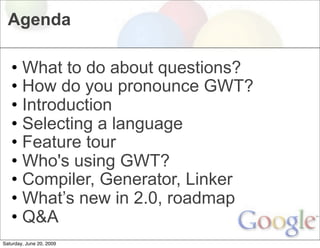























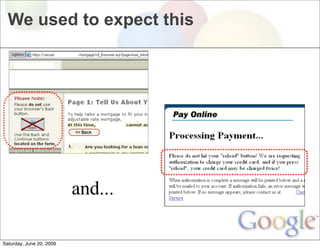





![Simple, powerful RPC
• Many formats: JSON, XML, custom
• Why not just speak one language?
interface SpellService extends RemoteService {
/**
* Checks spelling and suggests
* alternatives.
* @param the word to check
* @return the list of alternatives
*/
String[] suggest(String word)
}
Saturday, June 20, 2009](https://image.slidesharecdn.com/gwtoverviewandfeaturepreview-svwebjug-june162009-090621003200-phpapp02/85/GWT-Overview-And-Feature-Preview-SV-Web-JUG-June-16-2009-32-320.jpg)






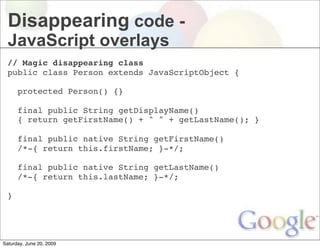












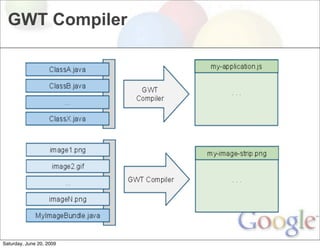
![What does the output look like?
You write...
Label foo;
foo.getElement().getStyle().setProperty("border",
"1px solid green");
GWT compiler (-style PRETTY)
foo.element.style['border'] = '1px solid green';
GWT compiler (-style OBFUSCATED)
var r='1px solid green', q='border';
b.i.style[q]=r;
Saturday, June 20, 2009](https://image.slidesharecdn.com/gwtoverviewandfeaturepreview-svwebjug-june162009-090621003200-phpapp02/85/GWT-Overview-And-Feature-Preview-SV-Web-JUG-June-16-2009-53-320.jpg)







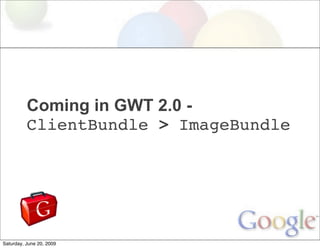



















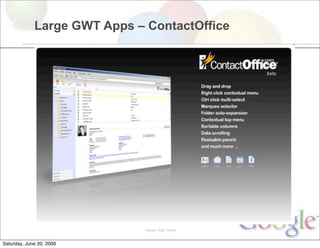
























































![Iobit Driver Booster Pro Crack Free Download [Latest] 2025](https://cdn.slidesharecdn.com/ss_thumbnails/informationtechnology5-250522164349-8a98d122-thumbnail.jpg?width=560&fit=bounds)


















